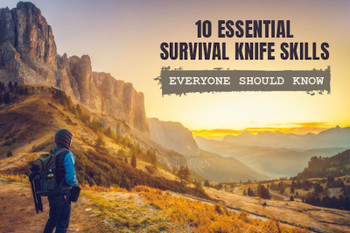10 Essential Survival Knife Skills Everyone Should Know
Feb 21st 2019
Your knife is the single, most useful tool to have in a survival situation. However, simply having the knife in your pocket isn’t enough to successfully survive in an emergency. Knowing these essential survival knife skills ensures you have the best chance of survival, no matter the situation.
1. Blazing a Trail
The ability to navigate through unknown terrain can mean the difference between life and death in the wilderness. Blazing a trail means you can find your way back to vital resources if necessary and can also help you make sure you aren’t traveling in a circle if you are without your GPS device or compass.
To blaze your trail using your knife, carve a small knick in the trees at regular intervals and at the same height if possible. Marks need to be deep enough to be noticeable but not so deep they harm the tree. You can carve arrows to point you or a rescue party in the right direction, but don’t spend too much time carving elaborate signs.
2. How to Start a Fire
Although there are different methods you can use to start a fire in a survival situation, when conditions are unfavorable, your knife can be an excellent way to get a spark going.
If you carry a Ferro rod with you when outdoors, you can use your knife to strike the surface and create a spark. However, if you find yourself without your gear and only your pocket knife to rely on, a stone offers the next best option when it comes to making fire.

To start a fire with a knife and stone, choose a stone that is jagged and hard enough to shave a small amount of steel from the blade, such as granite, jasper or flint. The type of knife you carry can also impact how easy it can be to create a spark; soft carbon steel blades spark more readily than tougher stainless steel.
Once you have found your stone, take a small piece of dry tree fungus and place it on top of the stone with the jagged striking edge facing away from your palm. Using the back of your knife, hit down hard vertically along the strike edge. It may take multiple strikes before the fungus catches the spark. Immediately transfer the spark to your prepared tinder bundle and gently blow to ignite the flame.
3. Making Tinder
Finding dry tinder in a damp forest can make it challenging to get a good fire started. Fortunately, you can create your own tinder using your survival knife and a small branch or twig.
A feather stick is the best way to make tinder in consistently wet environments, as the inner layers of wood are shaved finely enough that they readily catch a spark.
To make a feather stick, peel off the damp outer layer of bark from your stick. Position the stick vertically and push down with your blade to create thin curls of wood, making sure to leave the curls attached to the stick.
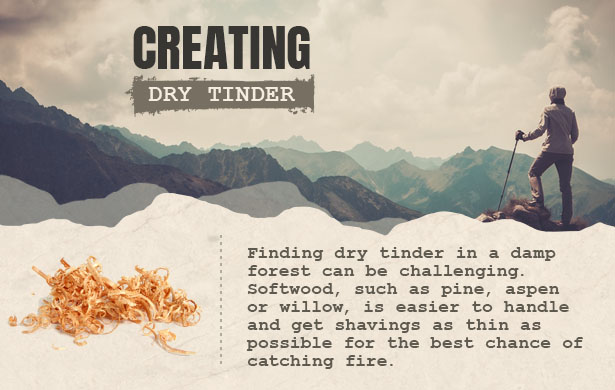
Softwood, such as pine, aspen or willow, is easier to handle and to get the shavings as thin as possible for the best chance of catching fire. Make several feather sticks before you start building your fire and have kindling and batoned (see below) firewood ready to add as the fire grows.
4. How to Baton Firewood
A roaring fire provides warmth, protection and somewhere to cook, but, to build a fire properly, you need a variety of sizes of wood. Branches that are too large will smother your fire before it gets going. Batoning wood enables you to create the right-sized kindling to keep your fire blazing.
Batoning wood works best with a large fixed-blade survival knife. Find a large branch, about as thick as a baseball bat, to drive the blade into the wood. Place a log vertically on a solid surface and position the blade horizontally in the center.
Use the branch to gently tap the blade into the surface of the log to secure the position, then use more powerful strokes to split the log in two. Ensure the end of the blade extends out from the log and remains parallel to the ground, as it can shift as you hit it.
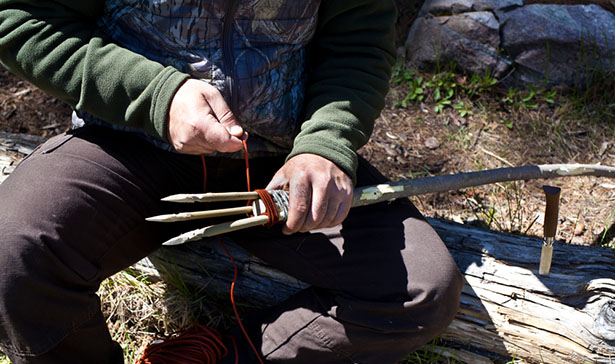
5. Whittling a Fishing Spear
Fish are an excellent source of high-quality protein in the wild. You also may not have the equipment on hand for line fishing. Using your survival knife, you can quickly and easily whittle a spear that can be used for fishing and other applications, such as supporting a shelter or for self-defense.
To make a fishing spear, find or cut a straight branch or sapling about eight feet in length. Use firm push strokes, holding the knife blade at a 45-degree angle, to whittle the end of the branch to a narrow point. Take your knife and split the narrow point in half, then split one of the halves in half again, so you have three prongs.
Use short paring strokes to sharpen the prongs before hardening them in a flame. Take a small piece of wood and wedge it between the prongs to separate them, and secure the wedge with either paracord or DIY natural rope. Add an additional looped piece of paracord to the opposite end of your spear for easy retrieval.
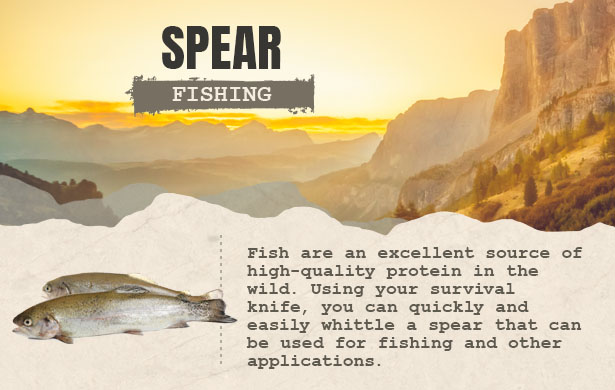
6. Building a Snare
Without a firearm, it can be challenging to hunt animals in the wild. However, setting snares is an effective way to catch a valuable source of protein. In an emergency, often the only materials at your disposal in the wild are rocks, sticks and natural fibers, so your survival knife becomes an essential tool for crafting a small game trap.
Before you set your snare, determine what type of animal you will be trapping as this will alter the structure of the snare you use. Spend a little time scoping the terrain to find runs which are the paths that small game animals use. Setting snares along these runs dramatically increases your chances of trapping small game. The more snares you set, the more likely you are to catch a meal.
One of the easiest snares to make is a spring snare. You need a live green sapling to act as the spring, two sticks to create the trigger mechanism and either snare wire or a noose made from a natural rope.
Carve the end of one of the sticks to create a stake and cut a notch about an inch down from the flat end before hammering it into the ground, using the handle of your knife. The second stick should be cut to fit the notch on the stake and then two smaller grooves cut into the top one inch apart to attach a rope which is then tied to the sapling.
In the second groove, attach the snare wire which should lie along the animals’ run. Connect the trigger to the stake, and your snare is set.
7. Field Dressing Small Game
After successfully trapping or hunting game, you must quickly process the carcass to prevent spoilage and potentially contract harmful diseases or parasites. Knowing how to field dress game in the wild ensures you have a good supply of safe, healthy protein to last you through a survival situation.

The big difference between field dressing big and small game is when you skin the animal. For small animals, such as rabbits and squirrels, skin them before removing the entrails. Larger animals should be skinned after the entrails are removed and the cavity has been cleaned.
When field dressing any animal, do not puncture the membrane that contains the entrails, as this can introduce harmful bacteria and fecal matter to the meat. Entrails should be removed from the crotch area upward, using small, sharp cuts to remove the tissue connecting the innards to the cavity.
Before eviscerating the animal, clean your hands and survival knife as well as possible. You might even consider boiling the blade first to remove as much bacteria as you can.
8. Breaking Glass
Survival situations don’t just happen in the wilderness. Often, emergencies begin in urban areas, and a good survivalist needs to be prepared for any eventuality. If you or someone else should become trapped inside a building or car, and the only exit is through a window, you can use your knife to safely break the glass and escape without injury.
Some pocket knives have glass breakers built into the handles; however, if yours does not, you can still use your knife to break a window. You need to use the toughest, pointiest part of your knife handle. Keep the pocket knife in the closed position and hold the opposite end in a tight choke grip to deliver the greatest force.
Avoid trying to break the windshield of the car. Aim for the side windows which will shatter rather than crack. Aim for the edge of the window which has less structural integrity than the center.
9. Self-Defense Against Wild Animals
In most cases, a blazing fire is enough to deter even the most curious wild critters. However, if you come across a territorial animal that is displaying aggressive or predatory behavior, your survival knife may be the only thing stopping you from becoming a meal.
Understandinghow most wild animals attack is the key to taking down large predators. Striking hard at vulnerable areas like the head, eyes and belly may not kill the animal outright, but it can give you a fighting chance to get away. Avoid throwing your knife at the animal, as they are likely to run off wounded and leave you without a vital survival tool.
10. Sharpening Your Knife
In the wilderness, a sharp knife is a safe knife. Heavy-duty use like batoning firewood and cutting paracord can quickly cause a razor-sharp blade to become dull. If you have left your knife-sharpening gear at home, there are a few ways that you can properly sharpen a pocket knife in the wild.
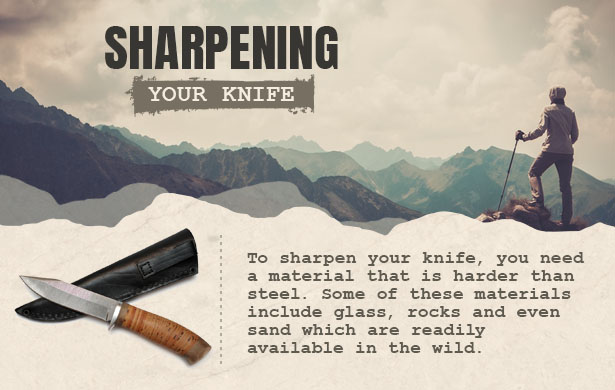
To sharpen your knife, you need a material that is harder than steel. Some of these materials include glass, rocks and even sand which are readily available in the wild. To sharpen your knife with a rock, choose a smooth river stone and draw the blade along the stone using long strokes while holding the knife at a 30-degree angle.
You can also make your own survival whetstone using a live tree branch and sand. Shave the bark off the branch and a few layers of inner wood to create a flat surface. Rub the sand into the flat side of the branch—the moisture in the branch will create a natural lubricant—and rub your knife backward and forward across the whetstone at a 30-degree angle.
Choosing the Right Survival Knife
When it comes to choosing a survival knife, it all comes down to finding a balance between durability and versatility. You want a knife that can be multifunctional which may lead you toward folding tactical knives. Proper care of your folding knife in the wild can keep your knife functioning throughout any situation. Follow these maintenance tips for folding knives to keep your knife in excellent working condition.
However, you also want your survival knife to withstand plenty of heavy-duty use in extreme conditions which gives fixed-blade knives the edge over other styles due to the stability of their full tang.
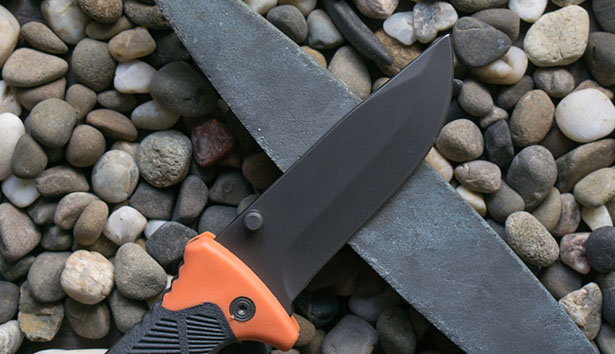
If you do choose a folding pocket knife for survival use, select a high-quality blade, such as a Microtech LUDT which uses premium materials like Elmax steel and a 6061-T6 milled aluminum handle. If you want to increase the versatility of your fixed-blade knife, there are many options that come with paracord handles which offer exceptional grip and provide you with additional resources in the wilderness.
Final Thoughts
There are many tricks and tips for using a survival knife for an outdoorsman, but regular practice using your survival knife skills is the key to successfully surviving in an emergency. To find out about the range of survival and tactical knives we have available, contact the support staff at eKnives at (423) 525-9477.

